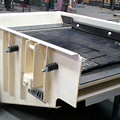How Brute Force Feeders and Grinding Makes for Efficient Mining Process
December 4, 2017
Technological solutions may enhance mining operations, but that doesn’t mean the traditional excavating methods are going extinct. To the contrary, brute force feeders are still grinding away behind the vibratory screeners and automated subsystems. They provide momentum, a primary energy front that moves the mineral stream forward. Built from moving weights and steel-reinforced assemblies, this robust single mass mechanism determines mining process efficiency.
What is A Brute Force Feeder?
Also known as a single mass drive system, this equipment predates most vibratory equipment. Check out the inner workings of this feeder, but don’t get too close. Look, there’s a lot of energy moving the feed inside the dusty jaws of this unit. And, unlike the oscillating decks that screen the fast-flowing extractive stream, this machinery is processing a coarser material load. Expect eccentrically mounted shafts and contra-rotating weights here, the kind of heavy-duty parts that produce an overpowering degree of brute force. Gifted with irresistible strength, it’s the stroke length of the equipment that keeps the coarse feed from jamming the process.
Nailing Stroke Length Mechanics
Located within a primary processing node in the extractive chain, brute force feeders use toughened motors to set up that linear stroke cycle. The motors operate in opposing directions, so the material throughput is caught in a drive-impelling maw. Carbon steel parts are installed here, which is as it should be, what with the high-volume rivers of rock impacting the pan lining of this feeder wrapping. As for the processing efficiency question, the stroke length is responsible for setting up a resonance field, one that drives the rocky surge. Meanwhile, outside this controlled zone of oscillating force, tempered springs offset the shaking energy. Just imagine, without those coiled springs, the whole feeder would likely shake itself apart.
An Enhanced Brute Force Product Line
What makes one brute force feeder better than its competitor? Well, heavy gauge alloys don’t abrade, so a superior material build makes all the difference. Next, a liner for the pan is a handy addition, for the rock surge is likely to be moving at some velocity. Finally, a finitely adjustable stroke length ensures effective drive force, so the site productivity factor stays satisfyingly high.
Every piece of mining equipment should be built to perform at its very best. However, it’s the front line gear that really defines the operational behaviour in a mining complex. Primary crushers are grinding, brute force feeders are moving the pulverized mineral load, and the extractive chain is experiencing the benefits of a tightly maintained feed stage. The resulting process efficiency, should it drop, can be restored by checking the stroke length of the feeder stage.
Optimized by: Netwizard SEO


